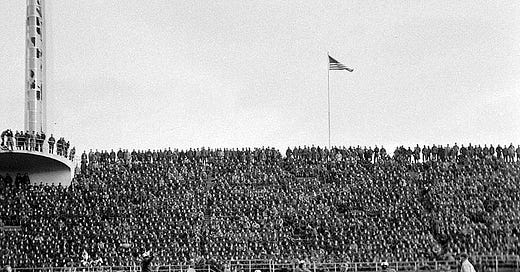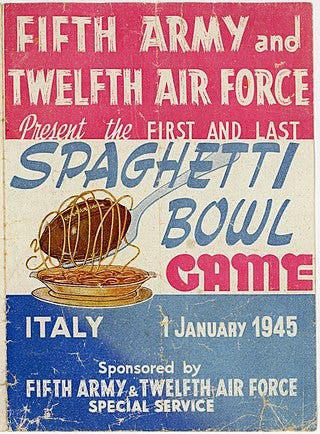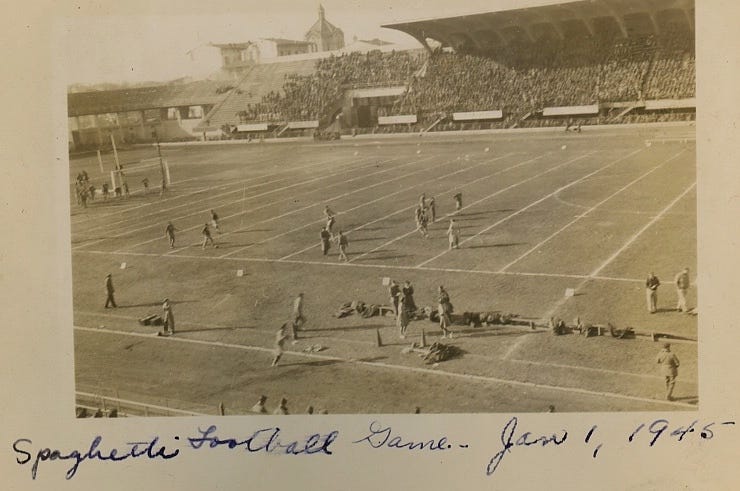Football provides a morale boost as WWII lingers: Recalling the New Year's Day Spaghetti Bowl of 1945
It was Jan. 1, 1945, and America was bracing for its fourth year of World War II, the most destructive war in modern history.
In the European Theater, Allied forces had stormed through North Africa, only to face intense fighting as they continued to forge a path up the boot of Italy and into the heart of Europe. The eventual goal was to take Berlin with months of bloody battles on the horizon. American troops felt the tide was turning in favor of the Allies, but wondered how long it would take for this godforsaken war to end.
On New Year’s Day, they needed a morale boost. They needed some good, old fashioned American football.
Billed as the “Spaghetti Bowl,” members of the Fifth Army and Twelfth Air Force donned helmets and pads and hit the gridiron for an afternoon clash in Florence, Italy. Heralded as the “first and last” Spaghetti Bowl, the game was played at Stadio Giovanni Berta under heavy security. The players, many with college and some with professional experience, practiced for three weeks leading up to the New Year’s bowl game, but reports of any organized practices were kept tightly under wraps. American forces did not want the German Luftwaffe to catch wind of the big event, especially with a reported 25,000 spectators — mostly military personnel — in attendance.
During the game, Lockheed P-38 Lightning fighter planes buzzed over the stadium to safeguard against any surprise attack from the Germans.
Fortunately, the event went off without a hitch and everyone was safe and sound. For a few hours, tired and war weary troops could forget about death, destruction and the march toward victory and peace and let their minds escape into the joys of football. By the 1940s, New Year’s Day bowl games had become an American tradition. The Spaghetti Bowl provided GIs a slice of life from back home they so dearly missed.
According to LIFE magazine, the game was held only “three hours’ jeep ride from the front” in the snow-covered mountains of Northern Italy. Troops traveled from the front that morning, enjoyed the game in Florence, and were sent back to the front that night.
The game itself wasn’t the most entertaining brand of football, but it mattered little. The Fifth Army, coached by Lou Bush, blanked the Twelfth Air Force 20-0. The Army appeared to have a more potent roster, featuring Sgt. Cecil Sturgeon, a tackle with the Philadelphia Eagles, and John “Big Six” Moody, a fullback with the Los Angeles Mustangs. Bush also was quite an athlete. An Army captain, Bush was a star football and basketball player at UMass and went on to play in the St. Louis Cardinals’ farm system.
The Air Force squad was led by team captain Lt. George Barnes, a former Maryland quarterback, and Bernard Buckiewitz, a tackle who was on the Green Bay Packers’ roster in 1945 but did not appear in an NFL game. The team was coached by George “Sparky” Miller, a major and former lineman and assistant coach at Indiana.
The Army outfit, dubbed the “Krautclouters,” and the Air Force unit, named the “Bridgebusters,” featured players from pigskin powerhouses such as Notre Dame to little known programs like the College of Puget Sound. A few GIs hadn’t played past high school, but it didn’t matter. All of these athletes and servicemen came together for their brothers in arms on a chilly, sunny afternoon in Florence.
Moody, a 230-pound bruiser, paced the Army squad with two rushing touchdowns, while Lt. Arthur Lemke, a receiver from Georgetown, hauled in a TD pass from Pvt. Frank Buel, a former Florida quarterback. As the team drove down the field, GIs packing the stands of the soccer stadium chanted, “We want a touchdown!”
Charles Able, a major serving in the Twelfth Air Force, helped organize the game for Special Services, which helped bring fun activities to troops to keep morale high. Able told the Oklahoman newspaper in 1995 that military vehicles were bumper-to-bumper en route to the game.
“Admission was free to anyone wearing an Allied uniform, but some civilians also slipped in,” wrote David Zizzo of the Oklahoman.
While there were three other games played in Europe on New Year’s Day, 1945, (including the Potato Bowl in Northern Ireland, Coffee Bowl II in London, and the Riveira Bowl in France), the Spaghetti Bowl was deemed as the de facto title game for service teams in the European Theater.
Action didn’t let up at halftime, as the intermission featured plenty of pageantry. Majorette Peggy Jean led a 56-member Army marching band, and members of the USO came to put a smile on troops’ faces. Broadway singer Ella Logan serenated the crowd and baseball stars Leo Durocher, Brooklyn Dodgers manager, along with Joe Medwick, an outfielder with the rival New York Giants, gave supportive pep talks.
Based on reporting and outstanding photojournalism from LIFE, Jean, twirling a baton in a skirt and white, leather boots, was the star of the halftime show. Confidently leading the band through its paces, Jean flashed a smile that cascaded throughout the stadium.
“They cheered two pretty Bowl queens and booed when the drum majorette tried to cover her legs from the cold,” noted LIFE.
To warm spectators from the crisp winter air, concession stands offered hot dogs, coffee and donuts, courtesy of the Red Cross. Members of the Women’s Army Corps rode parade floats constructed from military vehicles, and both branches crowned a queen from one of the WAC members.
“This was great stuff,” Able recalled to the Oklahoman on the game’s 50th anniversary.
The winter of ‘45 would bare many more casualties for the Allies as they relentlessly faced German resistance. But on this New Year’s Day, American forces had reason to celebrate and leave the horror of war behind in a beautiful haze of football, camaraderie, and dazzling majorettes.






